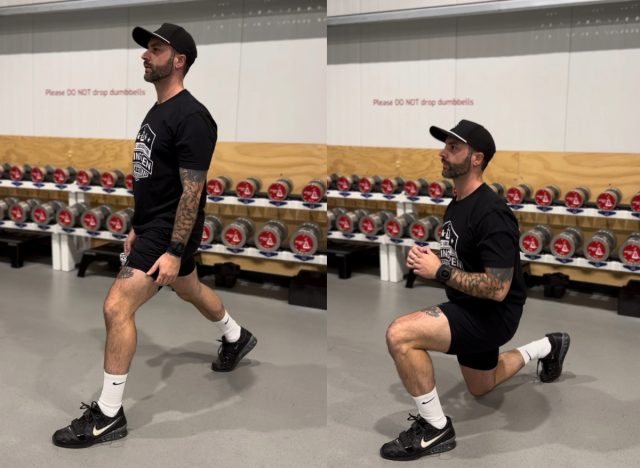The bodyweight squat is a foundational movement in fitness, essential for building lower-body strength, improving balance, and enhancing mobility. Mastering the squat lays the groundwork for more advanced exercises and functional movements in daily life. From getting out of a chair to jumping or lifting, squats are crucial in strengthening the legs, glutes, and core. You’ll protect your progress by learning proper squat form while building muscle and endurance.
Step-by-Step Guide
Step 1: Starting Position

- Stand tall with your feet shoulder-width apart, toes slightly turned out.
- Engage your core by pulling your belly button in towards your spine.
- Keep your chest lifted and your gaze forward.
- Place your arms straight out in front for balance, or clasp your hands together at chest height.
Step 2: Proper Movement Execution

- Begin by simultaneously unlocking your hips and knees and lowering your body.
- Track your knees over your toes as you lower your body, keeping your balance in your whole foot the whole time.
- Go as deep as your mobility allows, ideally aiming for thighs parallel to the ground.
- Ensure your chest stays up and your lower back remains neutral, avoiding any rounding.
Step 3: Finishing/Resetting the Position

- Press through your whole foot to push yourself back up to the starting position.
- Squeeze your glutes at the top of the movement to fully extend your hips.
- Reset your stance and repeat for the desired number of repetitions.
Form Tips
- Knee alignment: Ensure your knees track over your toes to avoid unnecessary strain.
- Weight distribution: Keep your weight evenly balanced throughout your whole foot.
- Breathing: Inhale as you lower down, and exhale as you push back up.
- Posture: Keep your chest up and core engaged to protect your lower back.
Muscles Worked
The bodyweight squat primarily targets the quadriceps, hamstrings, and glutes. It also engages the core to maintain stability throughout the movement. Secondary muscles include the calves and lower back, which assist in balance and control.
Benefits of Bodyweight Squats
- Incorporating bodyweight squats into your routine strengthens key muscles like the quads and glutes, which are essential for power, speed, and overall lower body function.
- Squats enhance mobility in the hips, knees, and ankles, improving your range of motion and flexibility.
- Since no equipment is needed, bodyweight squats can be done anywhere, making them versatile for home workouts.
- Squats promote better posture, teaching you to maintain an upright torso while strengthening the muscles responsible for balance and stability.
Common Mistakes and How to Avoid Them
- Rounding the lower back: Keep your chest up and engage your core to avoid slumping forward.
- Knees collapsing inward: Focus on aligning your knees with your toes by engaging the outer glutes.
- Lifting heels off the ground: Keep your weight in your heels by pressing them into the floor during the movement.
Not squatting deep enough: Aim for at least parallel thighs, but ensure your form remains tight. If mobility is an issue, work on flexibility to improve depth over time.
Exercise Variations
1. Dumbbell Squat

- Hold a dumbbell in each hand or a single dumbbell at chest height to add resistance, increasing the intensity and muscle engagement.
2. Barbell Squat

The pinnacle of squat variations is the barbell squat.
- Place a barbell across your upper back and shoulders to add significant resistance, allowing for greater leg and core strength development.
3. Split Squat

This variation isolates each leg, improving balance and unilateral strength.
- Step one foot back into a lunge position.
- Squat down, keeping the torso upright.
4. Jump Squat

- Perform a squat.
- Explode into a jump as you rise.
- Land softly back into the next squat.
How to Incorporate Squats Into a Workout
For a lower-body workout, perform 3 sets of 12-15 bodyweight squats, focusing on controlled form. For beginners, starting with 6-10 reps and gradually increasing is recommended.
You can also include squats in a circuit workout, alternating between exercises like rows, pushups, and crunches for 3-4 rounds with 8-12 reps each.
For a conditioning challenge, try doing jump squats for 30-second intervals with 30 seconds of rest between sets. Aim for 4 to 6 sets total.
Conclusion
Bodyweight squats are a must-have exercise in any fitness routine. They build lower body strength, improve mobility, and enhance balance. Whether you’re a beginner or looking for a full-body workout, incorporating squats with proper form and progressing over time will ensure lasting benefits and help you achieve your fitness goals.
Jarrod Nobbe, MA, CSCS










